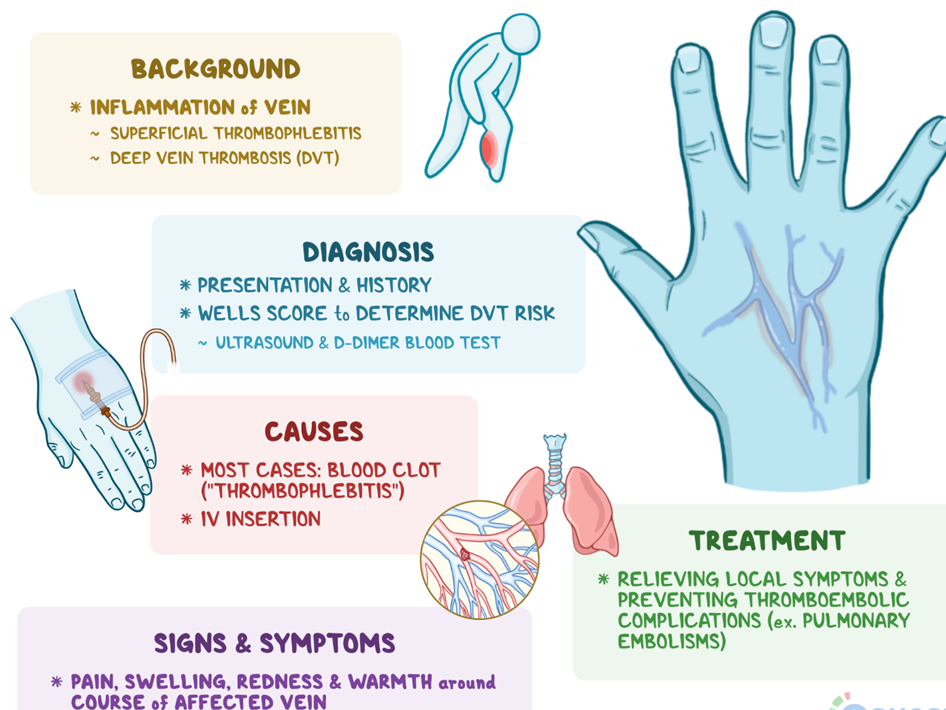A nurse is observing the IV catheter insertion site of a client who is receiving continuous IV therapy. Which of the following manifestations should the nurse identify as an indication that the client has developed phlebitis?
Coolness
Drainage
Pallor
Erythema
The Correct Answer is D
A. Coolness at the IV insertion site is not a typical sign of phlebitis. Phlebitis often presents with warmth or increased heat around the vein due to inflammation.
B. Drainage at the IV site might indicate infection or other complications but is not a specific sign of phlebitis. Phlebitis primarily manifests as redness, tenderness, and swelling along the vein.
C. Pallor (pale coloration) at the IV site is not a typical sign of phlebitis. Phlebitis usually presents with redness or erythema due to inflammation.
D. Erythema (redness) at the IV catheter insertion site is a hallmark sign of phlebitis. It indicates inflammation of the vein where the catheter is placed and is a common early sign of phlebitis. Other signs include warmth, tenderness, and swelling along the vein.

Nursing Test Bank
Naxlex Comprehensive Predictor Exams
Related Questions
Correct Answer is ["15"]
Explanation
To calculate the dose of amantadine for a client with parkinsonism, the nurse needs to use the formula: Dose (mL) = Ordered dose (mg) / Available dose (mg/mL) x Available volume (mL).
In this case, the ordered dose is 150 mg, the available dose is 50 mg/5 mL, and the available volume is 5 mL.
Plugging these values into the formula, we get: Dose (mL) = 150 mg / (50 mg/5 mL) x 5 mL.
Simplifying, we get: Dose (mL) = 15 mL.
Therefore, the nurse should administer 15 mL of amantadine oral solution to the client.
Correct Answer is ["C","D","E"]
Explanation
A. A client who has had prolonged diarrhea:
Prolonged diarrhea is not typically associated with an increased risk of aspiration during eating.
B. A client who has lactose intolerance:
Lactose intolerance primarily affects the ability to digest lactose-containing foods and does not directly increase the risk of aspiration.
C. A client who has had radiation therapy for head and neck cancer:
Radiation therapy to the head and neck can cause damage to the structures involved in swallowing, increasing the risk of aspiration.
D. A client who has had a stroke:
Stroke can affect the coordination of swallowing muscles, leading to dysphagia (difficulty swallowing) and an increased risk of aspiration.
E. A client who is 4 hr postoperative following a leg amputation under general anesthesia:
Postoperative clients under general anesthesia may experience impaired protective airway reflexes, making them prone to aspiration. It's important to monitor these clients closely during the initial recovery period.
Whether you are a student looking to ace your exams or a practicing nurse seeking to enhance your expertise , our nursing education contents will empower you with the confidence and competence to make a difference in the lives of patients and become a respected leader in the healthcare field.
Visit Naxlex, invest in your future and unlock endless possibilities with our unparalleled nursing education contents today
Report Wrong Answer on the Current Question
Do you disagree with the answer? If yes, what is your expected answer? Explain.
Kindly be descriptive with the issue you are facing.
